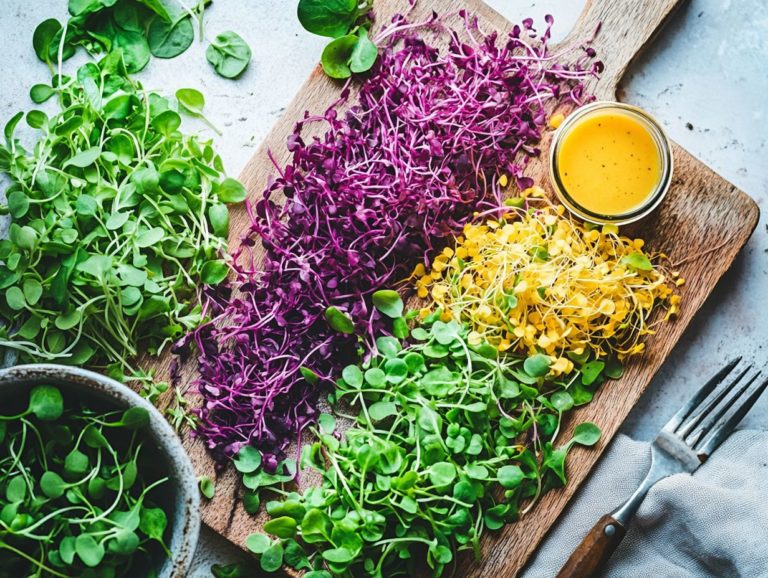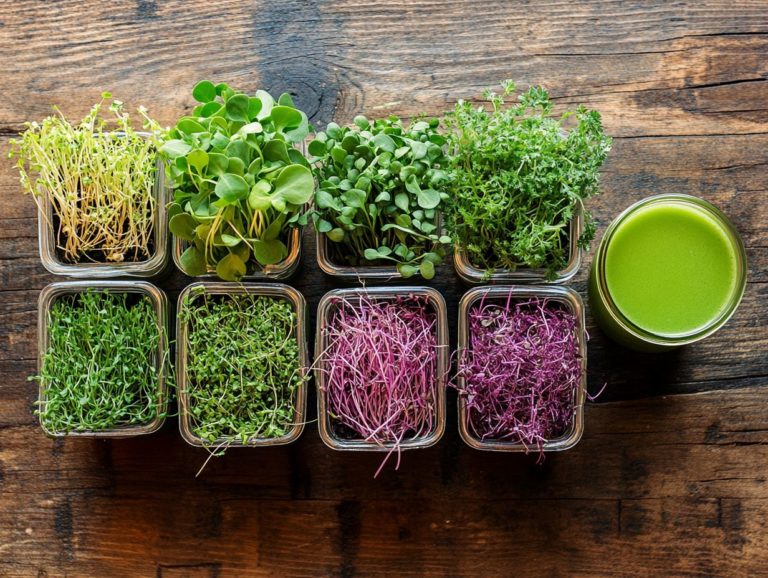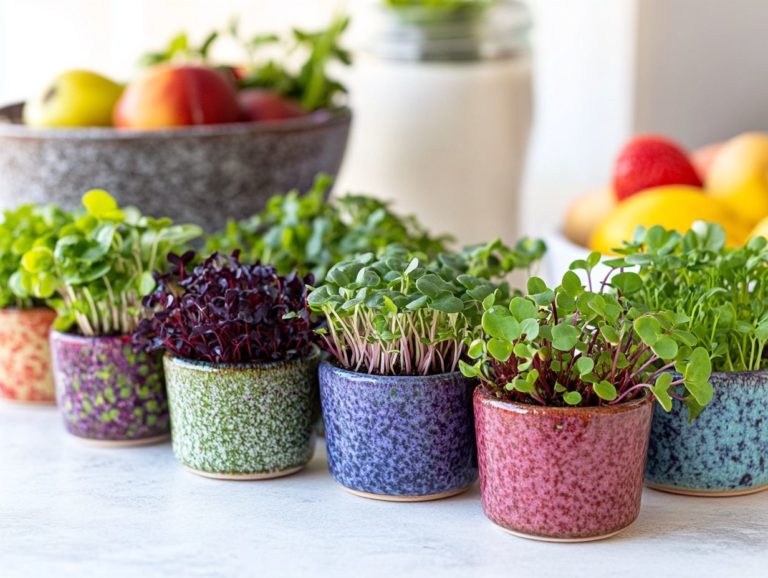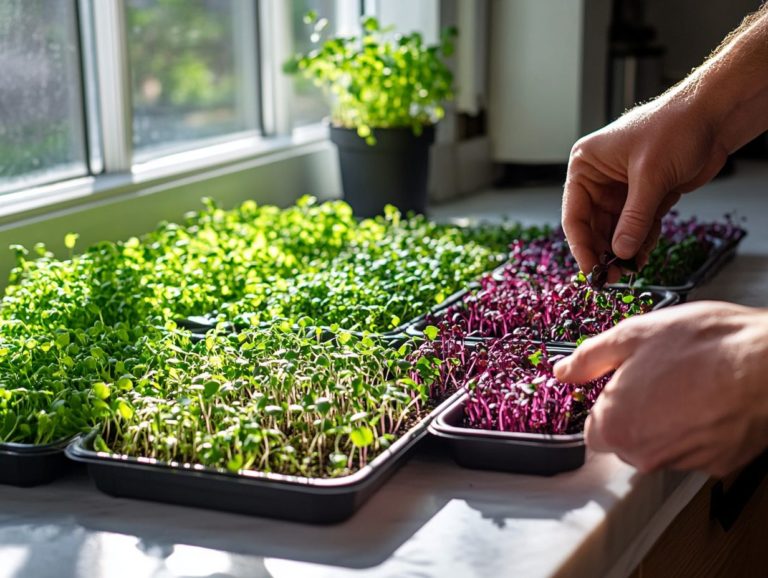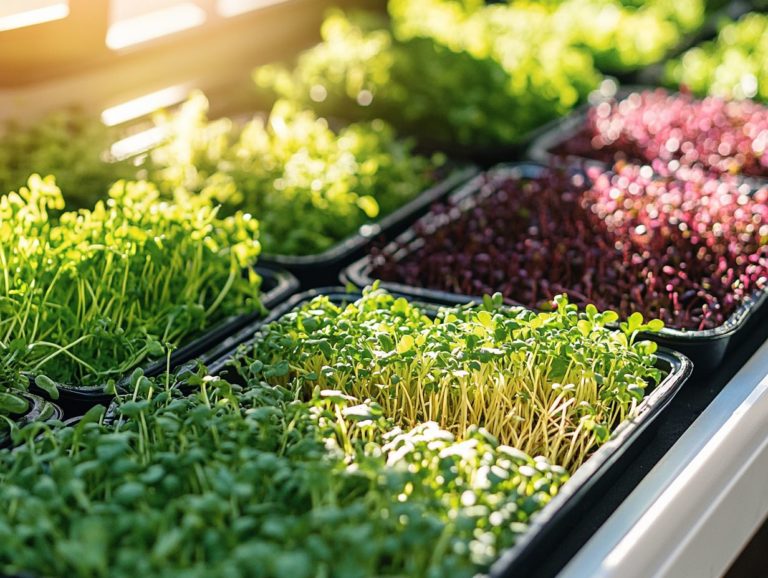5 Microgreen Varieties for Vibrant Bowls
Microgreens are tiny, nutrient-dense powerhouses that are revolutionizing the culinary scene. These miniature greens enhance flavor and elevate the nutritional profile of your meals, making them ideal for vibrant bowls.
Dive into five remarkable microgreen varieties broccoli, arugula, and chia included:
- Broccoli
- Radish
- Sunflower
- Pea
- Beet
- Basil
- Red Clover
These microgreens can truly transform your dishes. Uncover their nutritional benefits, explore creative culinary uses, and master growing methods along with harvesting tips and essential precautions.
Discover how to make your bowls not just a feast for the eyes but also a treasure trove of health benefits including the health benefits of different microgreens!
Contents
- Key Takeaways:
- 1. Broccoli Microgreens
- 2. Radish Microgreens
- 3. Sunflower Microgreens
- 4. Pea Microgreens
- 5. Beet Microgreens
- What Are Microgreens and Why Are They Popular?
- Frequently Asked Questions
- What are the top 5 microgreen varieties for vibrant bowls?
- Why are microgreens ideal for adding color and nutrition to bowls?
- How do pea shoots enhance the flavor of bowls?
- Can sunflower shoots be used as a substitute for leafy greens in bowls?
- What makes radish microgreens a popular choice for bowls?
- Are microgreens easy to grow at home?
Key Takeaways:
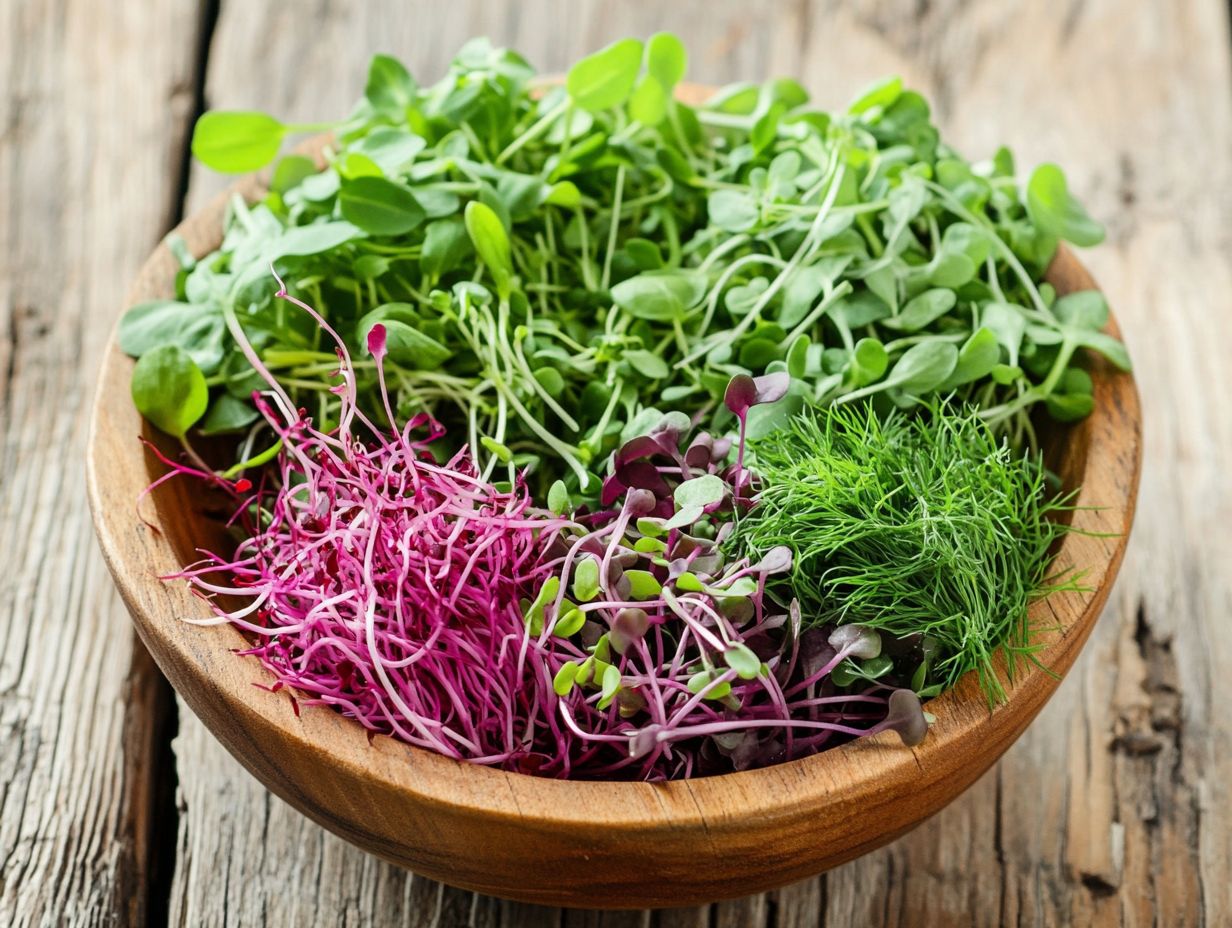
- Broccoli microgreens are rich in vitamins and minerals, making them a healthy addition to vibrant bowls, particularly in a microgreens salad.
- Radish microgreens add a spicy kick and a boost of antioxidants to your bowl, enhancing the overall flavor of microgreens.
- Sunflower microgreens provide a crunchy texture and are a good source of protein and healthy fats, perfect for growing right in your kitchen.
1. Broccoli Microgreens
Broccoli microgreens have become a go-to for health enthusiasts thanks to their impressive nutrient profile and delightful flavor. They re an effortless addition for anyone looking to grow microgreens at home.
Easy to cultivate, these tiny greens are packed with health benefits and add a flavorful twist to salads, smoothies, and an array of dishes. You can choose between various cultivation methods, such as growing them in soil or growing plants in water without soil.
Rich in essential vitamins C, A, and K, along with a powerful mix of antioxidants, these microgreens are your best friends for boosting health and enhancing your immune system.
If you’re interested in growing them, opt for soil growing to provide a rich, organic environment for the roots, or hydroponic systems that promote faster growth and reduce pest risks.
To seamlessly incorporate these vibrant greens into your daily meals, think about adding them to baby salad mixes:
- omelets
- sandwiches
- as a garnish for soups
- microgreens salad
Their peppery crunch not only elevates the flavor of your dishes but also amplifies their nutritional value, making every bite a healthful indulgence.
2. Radish Microgreens
Radish microgreens are truly a gem in the world of greens, renowned for their vibrant flavor and impressive nutrient density. If you re exploring the diverse universe of microgreens, you ll find these particularly enticing.
Their spicy kick can elevate any dish, making them a standout choice, especially in microgreen salads. With a high germination rate, they promise a successful yield, ensuring that your gardening efforts pay off.
You can easily cultivate them at home, making it a delightful option for anyone looking to enjoy fresh produce while keeping health in mind.
These petite greens burst with a zesty, peppery flavor that echoes their full-sized counterparts. They have the potential to transform even the simplest dishes into culinary masterpieces. Think of sprinkling them atop tacos or blending them into smoothies for an extra nutrient boost.
To unlock their full flavor and growth potential, it s crucial to create the right conditions. Start by soaking the seeds for a few hours before planting to enhance germination.
After that, place the seeds in a dark environment for about 2 to 3 days to encourage optimal sprouting. This blackout period allows the seedlings to push through with vigor, leading to a lush harvest that s not only rich in taste but also visually appealing.
Curious how to elevate your dishes with these tiny greens? Let s dive into their benefits!
We encourage you to try growing microgreens yourself or incorporating them into your meals for a boost of health and flavor.
3. Sunflower Microgreens
Sunflower microgreens are not just a feast for the eyes; they’re also brimming with health benefits. These easy-to-grow gems provide an excellent source of vitamins and minerals while adding a delightful crunch to your dishes.
Their mild, nutty flavor enhances salads, sandwiches, and smoothies, boosting both taste and nutrition. These tiny greens boast an impressive nutritional profile, packed with vitamins A, C, E, and essential minerals like magnesium and potassium.
With a high fiber content, sunflower microgreens can support better digestion. Sprinkle them on soups for texture, blend them into pestos and dressings, or use them as a garnish to elevate your dishes.
Sunflower microgreens effortlessly blend into various cuisines, offering a delicious way to fortify any meal while also highlighting the benefits of growing diverse microgreen varieties.
4. Pea Microgreens
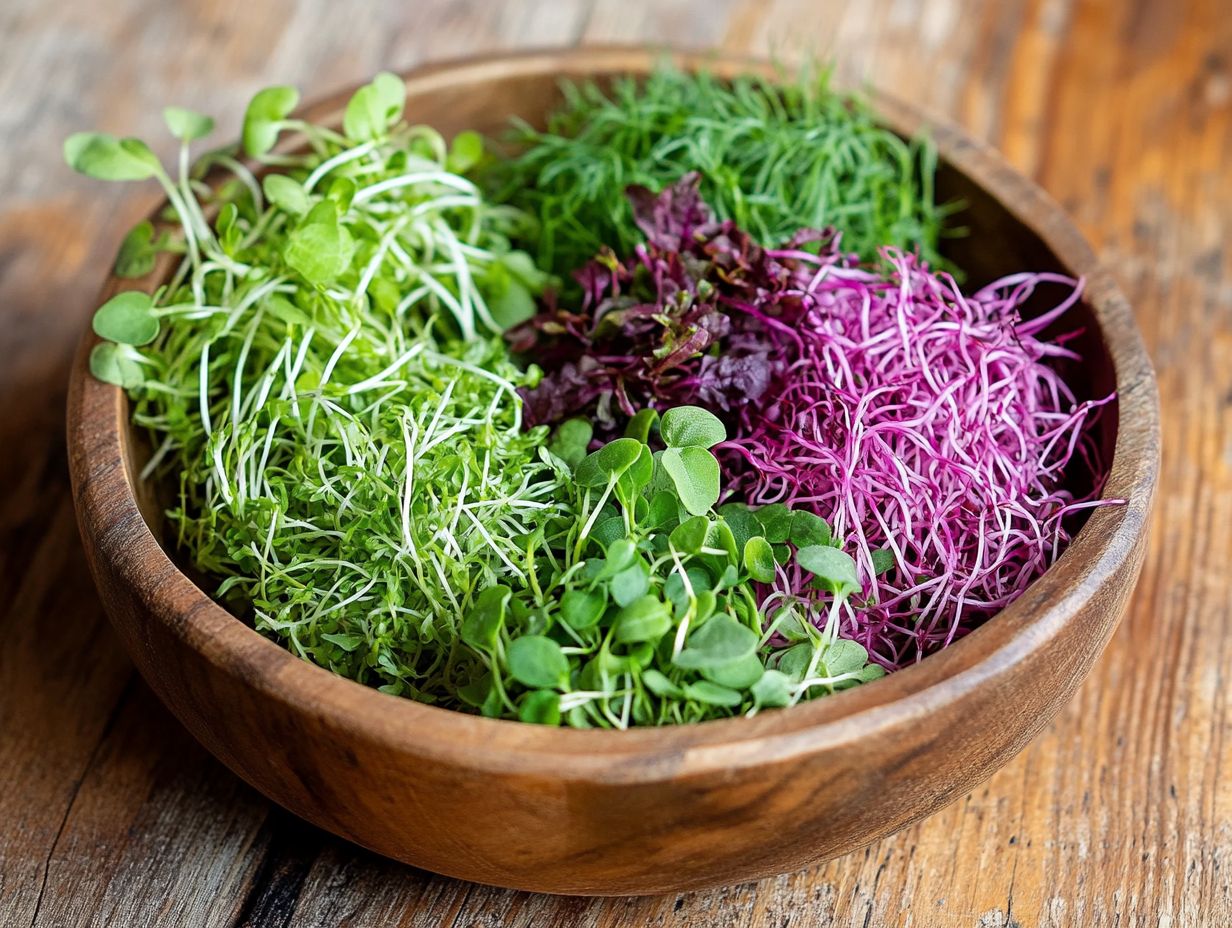
Pea microgreens are celebrated for their sweet, delicate flavor and impressive nutrient content. They re a fantastic addition to your microgreens collection, especially if you’re looking to introduce some variety.
Easy to grow right in your kitchen, these vibrant greens can be harvested for maximum taste and nutrition. Whether you use them on dishes or toss them into salads, pea microgreens enhance both flavor and health benefits.
To cultivate these delightful microgreens, use a seeding rate of around 1-2 ounces per flat of soil. Keep the seeds moist and warm for optimal germination, ideally in a dark spot for the first few days.
Harvest when they reach about 3-4 inches. This captures their sweetest flavor and densest nutritional profile. Try adding them to sandwiches, blending them into smoothies, or using them as a garnish on soups.
These tips will help your culinary creations soar, incorporating the full potential of microgreens!
5. Beet Microgreens
Beet microgreens offer a stunning burst of color and a delightful earthy flavor. Packed with vitamins and antioxidants, these tender greens add both taste and a wealth of nutritional value to your dishes.
Whether in salads, sandwiches, or as a garnish, beet microgreens elevate any meal. They are rich in antioxidants, which help combat harmful effects from free radicals and support overall health.
Incorporate them easily into recipes toss them into a vibrant smoothie or sprinkle them over roasted vegetables. Their slightly sweet and earthy taste pairs beautifully with many ingredients.
Use them as a crunchy topping for tacos or a fresh element in grain bowls. Their vibrant hue enhances the aesthetic of your dishes and signals the rich phytonutrients within.
What Are Microgreens and Why Are They Popular?
Microgreens are your ticket to vibrant flavors and concentrated nutrients, harvested just after the first true leaves emerge. These young, edible plants have taken the culinary world by storm, captivating health enthusiasts, chefs, and home gardeners alike with their impressive health benefits and versatility in the kitchen. Elevate your meals instantly with delightful options like broccoli, arugula, and sunflower. Plus, growing microgreens at home is a fulfilling hobby that lets you dive into their many culinary uses.
The growth journey starts with seed germination, leading to the development of cotyledons the first leaves which you can enjoy alongside the true leaves. This rapid life cycle typically unfolds over just two weeks, making it an attractive choice for anyone looking for quick results.
Their swift growth and simplicity in cultivation have made microgreens a rising star in modern cuisine, finding their way into salads, sandwiches, and as stunning garnishes. For those interested in exploring different types, a quick guide to common microgreen varieties can be invaluable. Health-conscious individuals appreciate the abundant vitamins, minerals, and antioxidants packed into these tiny greens, seamlessly integrating them into everyday meals to boost nutritional value without compromising on taste.
You can cultivate these little powerhouses in cozy spaces like your kitchen or balcony, making them an enticing option for aspiring gardeners eager to enhance their culinary skills through growing microgreens.
What Are the Nutritional Benefits of Microgreens?
Microgreens are nutrient-rich foods that offer a remarkable array of health benefits, often packed with vitamins and minerals at levels significantly higher than their mature counterparts. Rich in antioxidants and phytochemicals (natural compounds found in plants that may have health benefits), these tiny greens not only promote well-being but also elevate the flavors of your dishes, making them a favored choice in gourmet cooking. Understanding the health benefits of various microgreens allows you to handpick the best varieties to incorporate into your diet.
Take broccoli microgreens, for example they are brimming with sulforaphane, a compound celebrated for its cancer-fighting properties. Meanwhile, beet microgreens are loaded with nitrates, which can enhance blood flow and lower blood pressure. Adding microgreens like radish can introduce a zesty kick to your salads and dishes, all while providing a generous dose of vitamin C. To explore more about different types, check out the microgreen varieties: taste and flavor guide. These enriching profiles boost the nutritional value of your meals while sparking creativity in your culinary endeavors.
By experimenting with a vibrant array of microgreens, including the top 5 microgreens for smoothies, in different recipes, you can transform everyday meals into delightful and healthful experiences.
How Can Microgreens Be Used in Bowls?
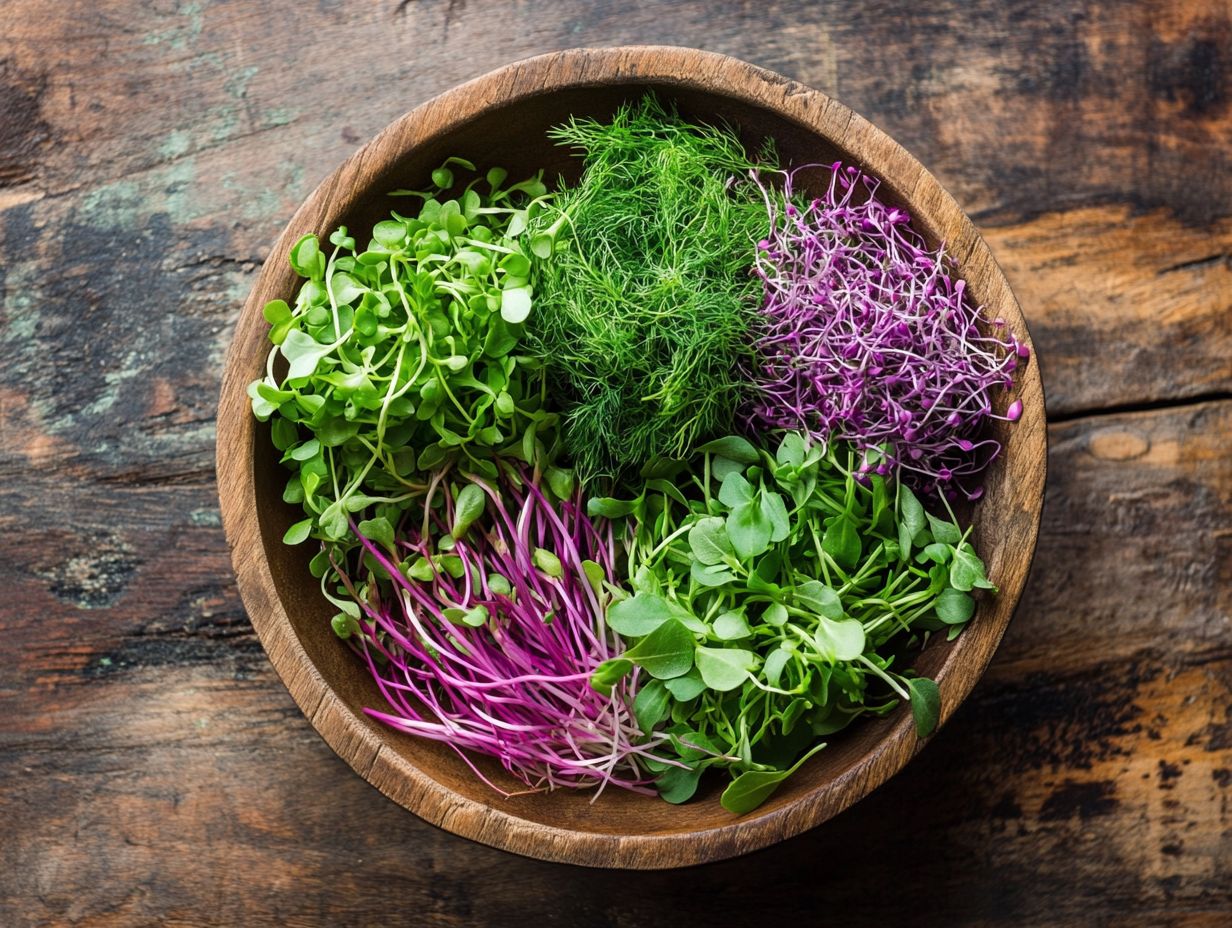
Microgreens can elevate your meals to new heights, adding both visual flair and nutritional benefits to an array of bowls. Whether you re crafting a grain bowl, salad bowl, or s smoothie bowl, these petite greens introduce layers of flavor and texture that beautifully complement other ingredients.
With diverse flavor profiles like the aromatic notes of basil or the zing of cilantro microgreens can transform even the simplest dishes into culinary delights, appealing to both health enthusiasts and gourmet aficionados alike.
Imagine a hearty grain bowl featuring quinoa, roasted vegetables, and a zesty lemon-tahini dressing, all topped with peppery arugula microgreens. Or picture a vibrant salad bowl, artfully combining mixed greens, cherry tomatoes, creamy avocado, and shredded carrots, enhanced by the sweetness of pea shoots. For those interested in expanding their microgreen options, check out microgreen varieties: a guide for beginners. In terms of smoothie bowls, incorporating sunflower microgreens can lend a delightful nutty undertone while packing in extra nutrients.
To achieve the best flavor experience, it’s wise to select microgreens that either echo or contrast with the dominant flavors in your bowl. For guidance on selecting the right options, check out how to choose microgreen varieties for your garden. This thoughtful pairing will help you create a harmonious and nutritious masterpiece you’ll want to savor again and again.
What Are the Different Ways to Grow Microgreens at Home?
Growing microgreens at home is a rewarding journey. You can explore various methods while enjoying flexibility in your gardening approach.
Whether you lean towards soil or prefer hydroponics a method of growing plants in water instead of soil each method has its unique advantages. You can yield delicious microgreens with minimal effort.
Techniques such as seed soaking can significantly enhance germination rates. This makes it easier for you to cultivate a diverse array of microgreens right in your kitchen.
The accessibility of these methods invites anyone to embark on this healthy and fulfilling growing adventure.
To kick off soil growing, choose a high-quality potting mix, lightly dampen it, and scatter your seeds evenly across the surface. Cover them with a thin layer of soil.
If hydroponics is more your style, plant food will provide essential minerals, while growing trays or mats will support seed germination beautifully.
Try growing varieties like sunflower or radish that thrive in soil. Basil and pea shoots tend to flourish in a hydroponic setup. Plus, additional techniques such as using a cover to keep moisture in or a grow light can further optimize growth.
Get started with vibrant flavors in just a couple of weeks!
How Do You Harvest and Store Microgreens?
Harvesting and storing microgreens with care is crucial for maintaining their freshness, flavor, and nutritional benefits. This ensures you savor them at their peak.
Understanding the ideal harvest time for various microgreens enables you to choose the perfect moment for picking. This can range from just a few days to a couple of weeks post-germination.
Once harvested, the storage method becomes vital for extending their shelf life. Employ techniques that preserve their crispness and flavor.
To pinpoint the right time to harvest, look for specific indicators: the leaves should reach their full size, exhibit vibrant color, and achieve the desired growth density.
For example, basil and cilantro are ready when their true leaves emerge, while mustard greens will hint at readiness through their zesty flavor profile.
After picking, rinse the microgreens gently to remove any soil residue. Ensure they re dried thoroughly.
Proper storage involves keeping them in a cool environment ideally between 34-38 F. Utilizing airtight containers lined with a slightly damp paper towel helps manage moisture levels.
This keeps your microgreens fresh and crisp without wilting.
Are There Any Precautions to Take When Consuming Microgreens?
While microgreens are packed with health benefits, it s crucial to keep a few precautions in mind for safe consumption. This helps you fully harness their nutritional potential.
Proper handling and hygiene play pivotal roles when growing and preparing microgreens. They can easily fall prey to contamination if not managed with care.
Understanding food safety is key. Always wash your hands and surfaces before handling microgreens to remove harmful bacteria.
Opt for organic seeds specifically designed for microgreens, as they generally present a lower risk of contaminants. Once you ve harvested them, give the greens a rinse under cool running water and dry them thoroughly before digging in.
Exercise caution with certain varieties known for harboring potential toxins, like alfalfa and clover. Cooking or steaming these can help mitigate risks while still allowing you to enjoy their nutritional perks.
By adopting these practices, you ll foster a healthy and safe experience with microgreens.
Frequently Asked Questions
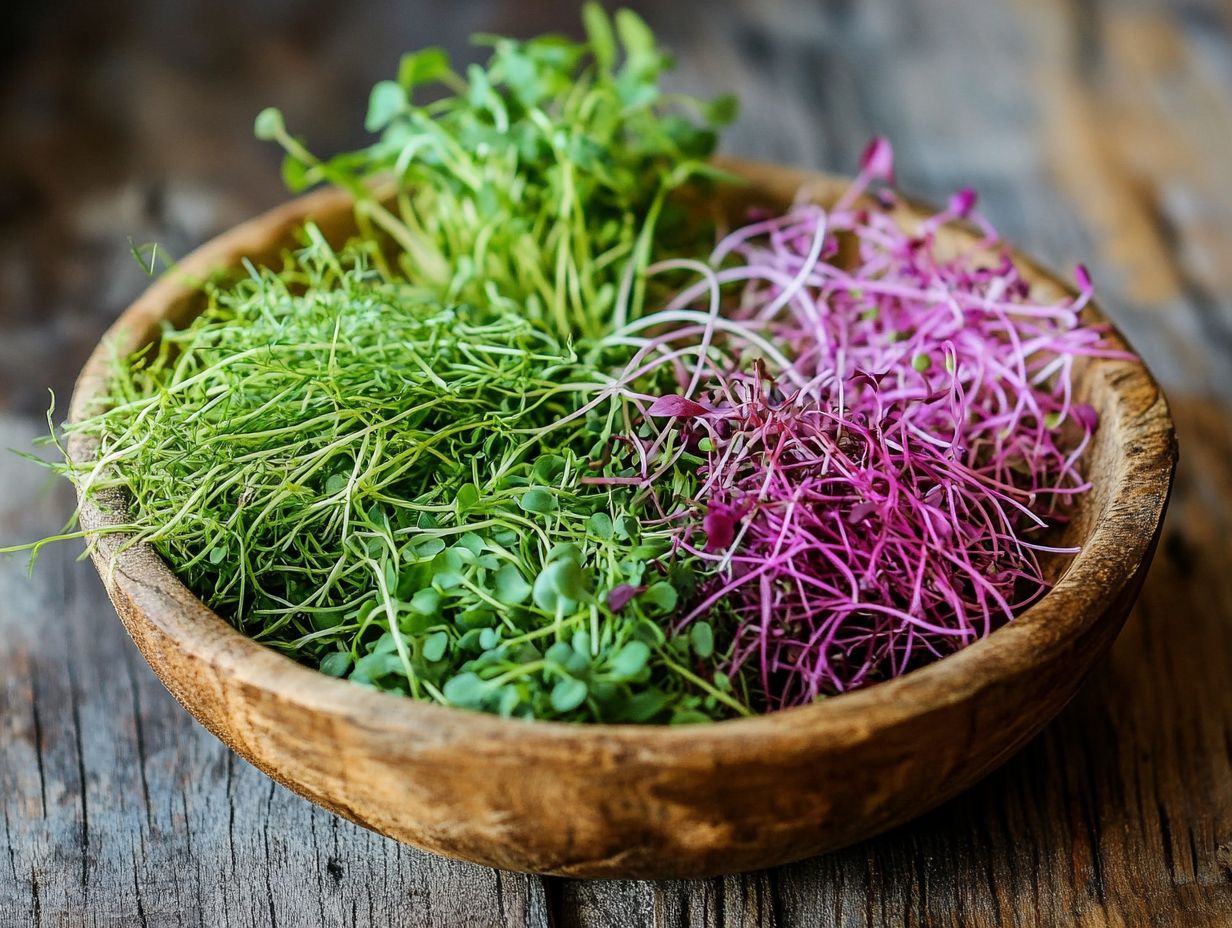
What are the top 5 microgreen varieties for vibrant bowls?
The top 5 microgreen varieties for vibrant bowls are pea shoots, sunflower shoots, radish microgreens, broccoli microgreens, and red cabbage microgreens.
Why are microgreens ideal for adding color and nutrition to bowls?
Microgreens are great for adding color and nutrition to your bowls. They are full of vitamins, minerals, and come in vibrant colors.
How do pea shoots enhance the flavor of bowls?
Pea shoots add a sweet and fresh flavor to your dishes. They also provide a satisfying crunch!
Can sunflower shoots be used as a substitute for leafy greens in bowls?
Absolutely! Sunflower shoots can replace leafy greens. They taste similar to spinach or kale and are loaded with vitamins A, B, and E.
What makes radish microgreens a popular choice for bowls?
Radish microgreens bring a spicy, peppery flavor to your bowls. They give your dish a zesty kick and are rich in vitamin C and potassium.
Are microgreens easy to grow at home?
Yes, growing microgreens at home is simple and doesn t require much space or equipment. You can grow them all year round for a fresh boost in your meals!
Try incorporating microgreens into your diet today and experience their colorful and nutritious benefits!

